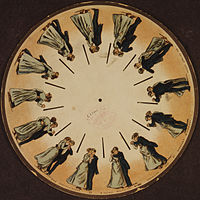Cave paintings
The earliest examples derive from still drawings, which can be found in Palaeolithic cave paintings, where animals are depicted with multiple sets of legs in superimposed positions, clearly attempting to convey the perception of motion.
Pottery of Persia
A 5,200-year old earthen bowl found in Iran in Shahr-i Sokhta has five images painted along the sides. It shows phases of a goat leaping up to a tree to take a pear. However, since no equipment existed to show the images in motion, such a series of images cannot be called animation in a true sense of the word.
Egyptian murals
An Egyptian mural, approximately 4000 years old, shows wrestlers in action. Even though this may appear similar to a series of animation drawings, there was no way of viewing the images in motion. It does, however, indicate the artist's intention of depicting motion.
Zoetrope
A Zoetrope is a device which creates the image of a moving picture. The earliest elementary Zoetrope was created in China around 180 AD by the prolific inventor Ting Huan. Driven by convection Ting Huan's device hung over a lamp. The rising air turned vanes at the top from which were hung translucent paper or mica panels. Pictures painted on the panels would appear to move if the device is spun at the right speed.
The modern Zoetrope contraption was produced in 1834 by William George Horner. The device is basically a cylinder with vertical slits around the sides. Around the inside edge of the cylinder there are a series of pictures on the opposite side to the slits. As the cylinder is spun, the user then looks through the slits producing the illusion of motion. No one thought this small device would be the initial beginnings for the animation world to come. As a matter a fact, in present day beginning animation classes, the Zoetrope is still being used to illustrate early concepts of animation.
Leonardo shoulder study (ca. 1510)
Seven drawings by Leonardo da Vinci extending over two folios in the Windsor Collection, Anatomical Studies of the Muscles of the Neck, Shoulder, Chest, and Arm, show detailed drawings of the upper body (with a less-detailed facial image), illustrating the changes as the torso turns from profile to frontal position and the forearm extends.
The magic lantern
The magic lantern is the predecessor of the modern day projector. It consisted of a translucent oil painting and a simple lamp. When put together in a darkened room, the image would appear larger on a flat surface. Athanasius Kircher spoke about this originating from China in the 16th century. Some slides for the lanterns contained parts that could be mechanically actuated to present limited movement on the screen.
Thaumatrope (1824)
A thaumatrope was a toy used in the Victorian era. It was a disk or card with two different pictures on each side that was attached to two pieces of string. When the strings were twirled quickly between the fingers the two pictures appear to combine into a single image. The creator of this invention may have been either John Ayrton Paris or Charles Babbage .
Phenakistoscope (1831)
The phenakistoscope was an early animation device, the predecessor of the zoetrope. It was invented in 1831 simultaneously by the Belgian Joseph Plateau and the Austrian Simon von Stampfer.
Praxinoscope (1877)
The praxinoscope, invented by French scientist Charles-Emile Reynaud, was a more sophisticated version of the zoetrope. It used the same basic mechanism of a strip of images placed on the inside of a spinning cylinder, but instead of viewing it through slits, it was viewed in a series of stationary mirrors around the inside of the cylinder, so that the animation would stay in place, and also provided a clearer image. Reynaud also developed a larger version of the praxinoscope that could be projected onto a screen, called the Theatre Optique.
Flip book (1868)
The first flip book was patented in 1868 by a John Barns Linnet. This was another step closer to the development of animation. Like the Zoetrope, the Flip Book creates the illusion of motion. A set of sequential pictures seen at a high speed creates this effect. The Mutoscope (1894) is essentially a flip book in a box with a crank handle to flip the pages.




No comments:
Post a Comment